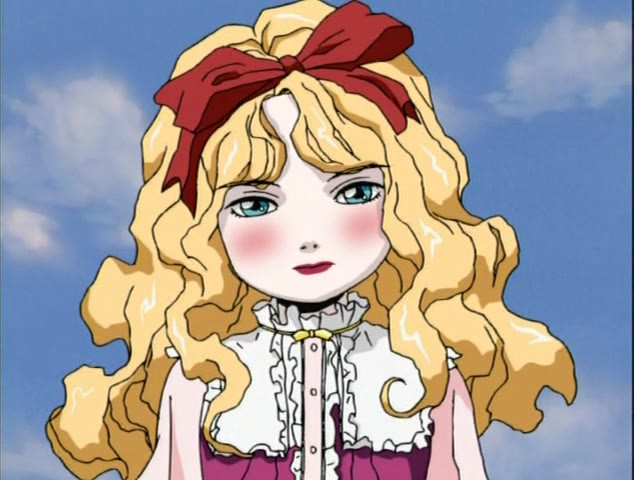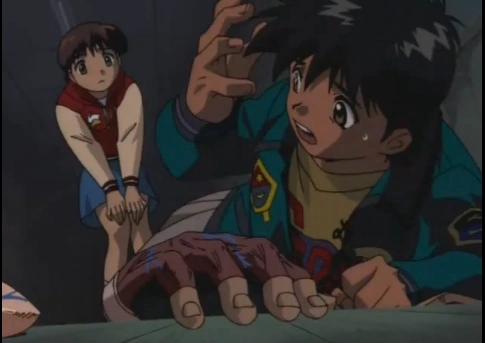 |
| From https://images-na.ssl-images-amazon.com/ images/I/61byuSfXZxL._SY445_.jpg |
Director: Noriyuki Abe
Screenplay: Hiroshi Hashimoto
Based on the book series by Toru
Tsunemitsu
Voice Cast: Tomoko Kawakami as
Satsuki Miyanoshita; Kumi Sakuma as Momoko Koigakubo; Takako Honda by Hajime
Aoyama; Makoto Tsumura as Leo Kakinoki; Kurumi Mamiya as Keiichiro Miyanoshita;
Ryusei Nakao as Amanojaku
Viewed in the Japanese language version with subtitles
Synopsis: In an idyllic Japanese town, Satsuki Miyanoshita moves
into her new home with her father and younger brother Keiichiro. Her mother,
passing away at a young age, was a gifted exorcist of ghosts and demons who
captured them in various parts of the town as Satsuki learns through an old
notebook she finds in an old schoolhouse. Unfortunately, as construction begins
around said town, these beings start to escape and she has to take over her
mother's task; all with the assistance of the cocky neighbour Hajime Aoyama,
nerdy ghost enthusiast Leo Kakinoki, the meek older girl Momoko Koigakubo, and
a demon named Amanojaku who has ended up possessing the body of her pet cat.
It took over four months to
finish all twenty episodes of Ghost
Stories, which I confess was laziness on my part. Immediately though I can
explain as well this was due to the one issue with Ghost Stories in terms of
its structure - that the series was clearly never meant to be marathoned, and
that for a more family friendly audience in tone, it is a spoiler when you
realise your cast (always at the centre of the ghost threats) will never be
harmed or get even in more than mild peril until the ending. This is an issue
in Eastern and Western storytelling which is going to sap tension to
everything, a vast difference to anime horror series based on an anthology
structure, where a central character is usually an outsider whilst the stories
are depending on episode specific figures that can be written to have good or
bad endings without restrictions. This was a frustrating aspect that
contributed alongside my aforementioned laziness in the long time viewing the
series.
 |
| From https://img1.ak.crunchyroll.com/i/spire3-tmb/ be8acd8de20518d1ec2c9f21ef7f929b1452213292_full.jpg |
Passing into the early 2000s where computers were used to make animation, it has aged with the simple colourful look, the world an innocent one which just happens to have death and monsters. Death itself is occasionally talked about in depth and an important aspect of Satsuki's back story with her mother, one of the few plot threads whose ghost is both revealed to be possessing the character of Momoko, never attempted to be obfuscated for the viewer, but also having in one of the more effecting moments part of talking about death as a natural state with a semblance of weight. It does it a lot better, for example, then one episode that concludes in a monologue about the circle of life but after a young girl resurrects a school rabbit by voodoo doll only for it to become a were-rabbit, and not the nice Aardman Animations version either.
For most of it thought, it's the
equivalent of a ghost ride, one which has an unintentional humour in how easy
it is for the junior ghost team to come across them but still about chills for
thrills in the outcome. Ghosts in this world have moved online or possessing
the radio studio in the school, they're headless gang members on motorbikes, or
Beethoven like psychopathic pianists, which I have to admit at least kept
things unpredictable even if the plots were usually the gang of leads, together
or in character specific episodes, accidentally coming across peril. It has some
ghoulishness but for the most part, it's not dissimilar to the Goosebumps book series in the West by R.L. Stein that I grew up with. In fact,
if it wasn't for the reoccurring jokes about Hajime constantly seeing Satsuki's
underwear and her to constantly chastise him for it, or the little bit of blood
which is more appropriate, this would easily play on Western television with a
little bit of censorship.
Incidentally, before someone
asks, this review is entirely about the original Japanese dub version, aware
that Ghost Stories' legacy is
entirely about the infamous ADV
English dub. The series flopped in its home land, arguably why it has the
unconventional twenty episodes length rather than the usual twenty four or
twenty six. As long as the character names and plotting were the same per
episode, ADV were told by the series
creators, Pierrot and Aniplex, to do what they wanted to this pre-existing
turkey as it was already viewed as a failure, ADV turning it into an intentionally comedic dub that took the piss
out of the material and deliberately went for offensive jokes. It was
improvised greatly but noticeably it's also a dub directed by Steven Foster, one of the most divisive
English dub directors in existence for his notoriously "loose"
translations of the original Japanese scripts. The little I have seen sides on profanity,
incredibly dated jokes in the George W.
Bush era mocking Republicans and Evangelicals by turning Momoko into a mad
Christian zealot, and frankly a tone that might be insufferable to see all
twenty episodes of even if they cast a favourite voice actress of mine Hilary Haag, when I used to like
English dubs, as the lead. The first episode, to its credit, is interesting but
whether it sustained a full show is an issue with this official parody dub.
 |
| From https://vignette.wikia.nocookie.net/ghoststoriesanime/images/f/f7/ Akagad.png/revision/latest?cb=20110917203545 |
The Japanese dub version as it is was fine, only with the paradox that this team of reoccurring leads is both a hindrance and a virtue, on the short term repetitious in plotting but in virtue in how I grew to like these characters. In general, it's hard to kick to the curb a show, for all its low production value and moments of stumbling, when it's this innocuous. If it wasn't for the few inappropriate things, it would be a show for a kid which is charming. And in terms of the story of the lead's deceased mother, there's even an episode that actually tries tugging at the heartstrings. Eventually the repetition is just an excuse to focus on a cast who are significantly more naive; the paradox is compounded that due to the cast, characters more likely to be afraid and lost in the scenarios around them, it should arguably make the material more logical in how they react to it all in spite of the series' problems.
One good move, that does help, is
that the story includes an actual demon in Amanojaku, who is at heart
eventually going to love them as a group but is a mischievous figure, one who
will help but only when he's bothered, and is compounded by the fact that he's
stuck in the body of a cat after the end of episode 1. Like any Japanese horror
anime, unless it's to do with vampires and Western tropes, I'm immediately
going to be intrigued as they'll be showing Japanese mythology in all its idiosyncrasies
even if the screenwriters were making stuff up; if Ghost Stories had expanded episodes to multiple parts, like Satsuki
becoming involved in a group of girls involved in black magic, the series
might've found a bit more meat to its bones without sacrificing the tone.
Beyond this, the only really
ridiculous aspect is that end credit song, infamous in itself (Sexy Sexy by CASCADE) because of its highly suggestive lyrics and a chorus
including the lines "sexy, sexy", a song that has become an earworm
for me and is fun, but is in the wrong show even if (again with the paradox) it
adds to the personality. Sadly the reason Ghost
Stories is known still in the West, and deserving its own review, is that
infamous English dub that has overridden the original version in niche anime
culture. Whether that version is better for me or not depends on actually
viewing it all; in the original Japanese version, I'm always going to have a
soft spot for anime horror, not matter how many flaws Ghost Stories ultimately has.

No comments:
Post a Comment